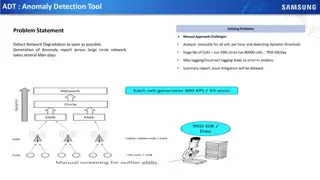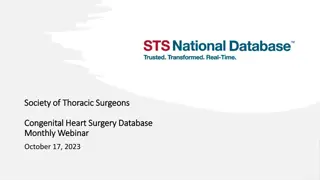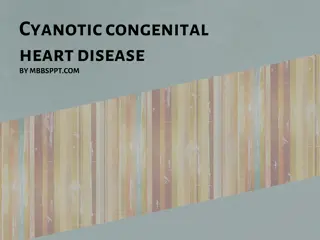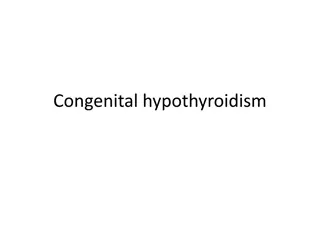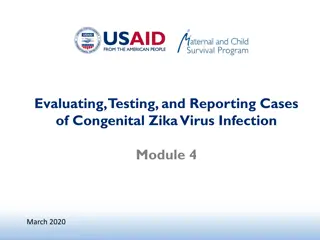
Congenital Anomalies and Their Types
Explore the definition, causes, symptoms, and treatment options for congenital anomalies. Learn about different types such as structural anomalies, heart defects, limb reduction, and cleft lip/palate, along with how they can impact individuals from birth. Discover the complexities of these conditions and the importance of early detection and intervention.
Download Presentation

Please find below an Image/Link to download the presentation.
The content on the website is provided AS IS for your information and personal use only. It may not be sold, licensed, or shared on other websites without obtaining consent from the author. If you encounter any issues during the download, it is possible that the publisher has removed the file from their server.
You are allowed to download the files provided on this website for personal or commercial use, subject to the condition that they are used lawfully. All files are the property of their respective owners.
The content on the website is provided AS IS for your information and personal use only. It may not be sold, licensed, or shared on other websites without obtaining consent from the author.
E N D
Presentation Transcript
StudyMafia.Org Congenital Anomaly Submitted To: Studymafia.org Studymafia.org Submitted By:
Table Contents Definition Introduction Types of Congenital Anomaly Symptoms of Congenital Anomaly Causes of Congenital Anomaly Risk-Factors of Congenital Anomaly Complications of Congenital Anomaly Treatment of Congenital Anomaly Prevention of Congenital Anomaly Conclusion 2
Definition A birth defect, or congenital anomaly, is any medical condition a person has from birth. Congenital means acquired in the womb. 3
Introduction These medical conditions range from mild to more severe. Some affect the organs or a single body part, while others can affect development, how the body works, or the senses. Most congenital anomalies have no obvious cause. Some are genetic, while others have a link to the woman s health during pregnancy. It is also possible that environmental factors play a role. Congenital anomalies affect around 3% of pregnancies. It is possible to reduce the chance of some of these irregularities, but not all of them. 4
Types of Congenital Anomaly Structural anomalies Some common structural congenital anomalies include heart defects, spina bifida, a cleft lip or palate, and clubfoot. Heart defects The most common congenital anomalies are heart defects. Most have no obvious cause, but if a pregnant woman has diabetes or smokes during pregnancy, it may increase the chance. 5
Types of Congenital Anomaly Structural anomalies Limb reduction Sometimes, part of a limb will not fully form in the womb. Known as limb reduction, this structural anomaly means that a limb is smaller than the usual size or missing altogether. For example, an infant may have a missing finger, clubfoot, or an arm that is shorter than usual. 6
Types of Congenital Anomaly Structural anomalies Cleft lip or palate If the tissues forming the roof of the mouth or lip do not join properly, it can cause a cleft lip or palate. Some infants may have both. This can affect speech, hearing, and eating. Most infants with this structural anomaly will need surgery in the first few months of life. In severe cases, they may need ongoing surgeries. 7
Types of Congenital Anomaly Structural anomalies Gut and stomach anomalies Sometimes, the stomach muscles do not form properly and leave a hole near the belly button. This can mean that the intestines or organs are outside of the body. In gastroschisis, the abdominal wall does not completely close, so the bowel can push through and develop outside of the body. 8
Types of Congenital Anomaly Developmental issues Developmental issues are not always congenital anomalies. Down syndrome: A person with Down syndrome is born with an extra chromosome. This affects brain and body development. Around 1 in every 700 babies born in the U.S. have Down syndrome. 9
Types of Congenital Anomaly Developmental issues Visual impairments: A visual impairment affects sight. The cause is an irregular eye shape or the fact that the brain and eyes do not work together properly. Hearing impairments: These occur when the ear does not work properly. This can be genetic. Fetal alcohol spectrum disorders: These can occur if a woman drinks alcohol during pregnancy. 10
Types of Congenital Anomaly Developmental issues Cerebral palsy: This is the most common childhood motor disability. It affects balance, movement, and posture Muscular dystrophy: This affects the muscles, which become weaker over time. Genetic disorders:This affects normal brain development and can affect learning and behavior. Specific language impairment: This is a communication disorder. It can affect a person s ability to read, write, and speak. 11
Causes of Congenital Anomaly It is not possible to prevent every congenital anomaly. Approximately 50% have no obvious cause, while some have a link to maternal health. A lack of folic acid increases the chance of some medical conditions relating to the brain and spine. Drinking alcohol during pregnancy increases the chance of fetal alcohol syndrome. Smoking during pregnancy increases the chance of cleft lip and palate. It can also increase the chance of premature birth and low birth weight. 13
Causes of Congenital Anomaly Fever and exposure to high temperatures during pregnancy can increase the chance of certain congenital anomalies, especially those that involve the development of the brain and spinal cord. Infections during pregnancy can increase the chance of hearing loss in the infant. Maintaining good health and limiting risk factors can reduce the chance of health problems for the infant. 14
Diagnosis of Congenital Anomaly A medical professional can diagnose some congenital anomalies during pregnancy. Prenatal tests check the health of a pregnant woman and the developing fetus. These tests include: Noninvasive prenatal screening A nuchal translucency ultrasound scan The quad screen 15
Treatment of Congenital Anomaly Some minor congenital anomalies do not need treatment. However, severe structural anomalies often need surgery shortly after birth. Prenatal testing can often detect a structural anomaly in the womb and help medical professionals, parents, and caregivers prepare. 16
Treatment of Congenital Anomaly Congenital anomalies can cause lifelong disability. A person may need additional care or support to live the fullest possible life. This can involve ongoing surgeries or long-term medication. People can ask a doctor for advice, support, and information. 17
Prevention of Congenital Anomaly Take 400 micrograms of folic acid per day during pregnancy. See a medical professional regularly. Avoid alcohol, cigarettes, and recreational drugs. Check that medications are safe to use in pregnancy. Try to prevent infections. Try to avoid getting too hot. Seek prompt treatment for fever. Maintain a moderate weight. Manage diabetes as best as possible. 18
Conclusion Congenital anomalies can be defined as structural or functional anomalies that occur during intrauterine life. Also called birth defects, congenital disorders, or congenital malformations, these conditions develop prenatally and may be identified before or at birth, or later in life. 20
REFERENCES Google.com Wikipedia.org Studymafia.org Slidespanda.com
THANKS TO STUDYMAFIA.ORG

